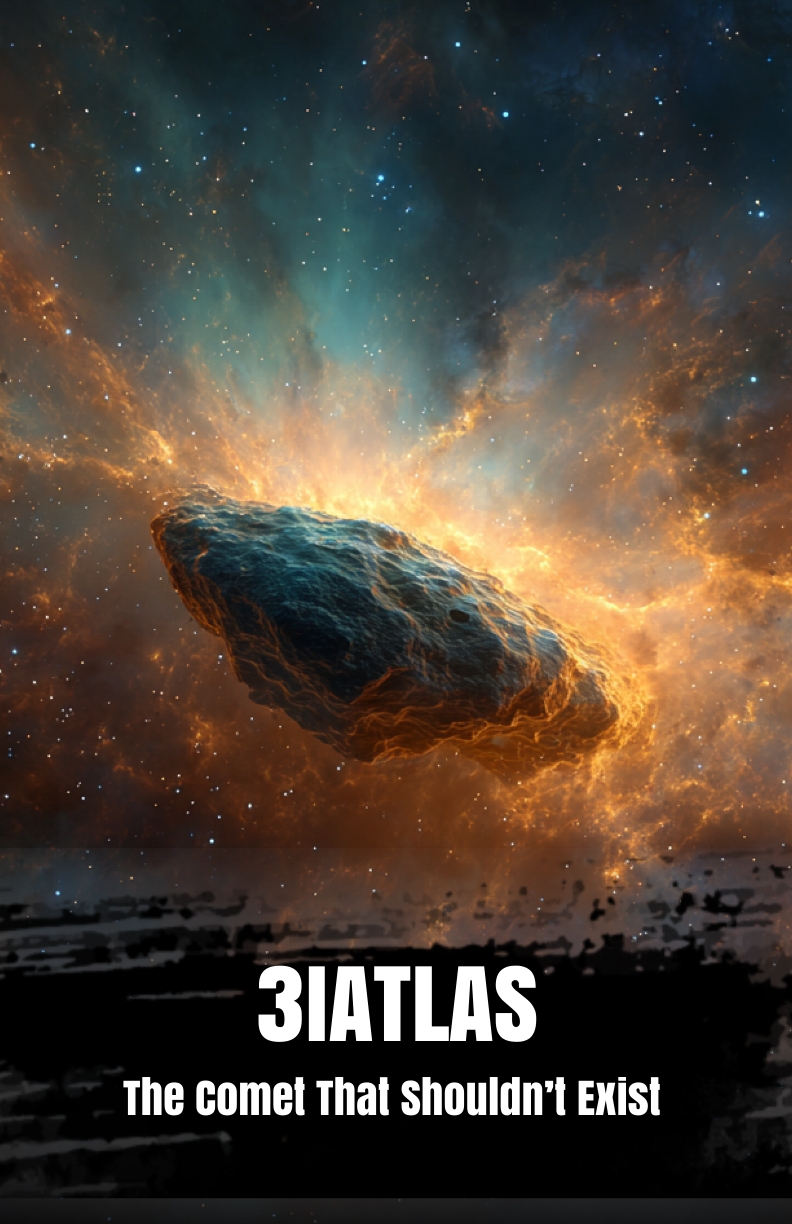Your cart is currently empty!
Frost in the Lungs

An unreleased short story from the book: 3I/ATLAS: The Comet That Shouldn’t Exist
It began as something small.
The hospitals called it a curiosity, a “transient thermal anomaly.” Patients with no signs of fever or infection, sitting upright in examination rooms, would speak—and a cloud of frost would bloom from their lips. Not the vapor of breath on a winter morning, but white rime, delicate and glittering, as though they were exhaling the contents of a freezer.
I was on the night shift in the ER when the first case came through our doors.
—
The man’s name was Gavin Rusk. Forty-eight. Construction foreman. He’d walked in under his own power, insisting he wasn’t sick. His complaint was simple: he kept seeing his breath indoors.
The triage nurse led him into a bay, and I followed. The fluorescent lights hummed overhead, cold and even, as he spoke. And there it was—a slow roll of frost from his mouth, curling into the air and hanging there, impossibly suspended.
It didn’t dissolve. Didn’t melt. Just… drifted, a loose spiral, moving not with the currents of the room but toward me.
I stepped back.
—
Two weeks earlier, 3I/ATLAS—C/2025 N1—had come into naked-eye range. People everywhere had been watching the interstellar comet climb the night sky, a long green scythe scraping the darkness. Newsfeeds carried images from telescopes—its nucleus faintly pulsing, its tail bending subtly in a way no one expected.
Astronomers said its composition was unusual. They spoke about isotopic ratios and unfamiliar volatiles, but what stuck in my head was the word cryogenic.
—
Rusk’s vitals were normal. No cough. No shortness of breath. But his frost lingered in the air until the nurse brushed through it—at which point she froze, not from cold but from the sensation.
“What is it?” I asked.
She shook her head. “It… touched me.”
The frost had broken into tiny threads that slid along her skin before vanishing.
—
The cases multiplied. By the third day, our hospital had twenty patients with the same symptom. Most were from the same quadrant of the city—the one where the night wind funneled in from the open plains.
The frost grew stranger.
It began to form patterns.
—
I saw it for the first time while checking a man in bed six. His name was Harris. The frost from his mouth rose in a lazy coil, then split into two thin arms that curved back toward him. Like hands, slow and searching.
The air was still. The room temperature was steady. There was no way for a breath to behave like that.
When I leaned closer, I felt it—a cool, deliberate movement, not a draft. The frost’s arms drifted toward my lips.
I stepped back fast, heart hammering.
—
By the end of the week, the patterns had become unmistakable—loops, spirals, slow rolls toward open mouths.
It didn’t matter if the person was awake, asleep, or unconscious. The frost sought out warmth. Life. Breath.
We began wearing masks full-time. Not surgical masks—thick, triple-layered ones meant for chemical hazards. It slowed the frost, but didn’t stop it. Sometimes, the patterns pressed close to the mask surface and lingered there, as if… thinking.
—
One patient—Maribel Ortiz—was brought in after collapsing on her porch. She was breathing, but barely. Frost poured from her mouth in steady ribbons, tracing symbols in the air.
Claire, our respiratory therapist, was the first to say it: “They’re not random.”
We filmed the patterns. Played them back in slow motion. They were consistent. Repeating.
—
Someone compared them to old astronomical notations. The resemblance was uncanny—spirals for galaxies, arcs for comet paths, dots for stellar positions. Claire overlaid one sequence onto a star chart.
It matched the sky on the night ATLAS had first been sighted.
—
The frost began appearing in people with no symptoms at all. A co-worker bent to tie her shoe and exhaled—a faint glimmer in the air. She didn’t see it.
But I did.
The glimmer twitched midair and turned toward her mouth.
—
The city health department told us to keep quiet. They called it “contained.” But you could see it now in the streets, especially at night—brief flashes in the glow of streetlamps, drifting like pale jellyfish.
And they didn’t always come from people anymore. Some floated in from the open air, moving in lazy, purposeful arcs.
—
Then the first death.
A patient named Nolan. He’d been breathing normally one moment, frost curling lazily above him. Then it thickened—became a solid ribbon. It slid into his mouth in one long, unbroken strand.
His eyes froze wide. Frost bloomed in his pupils.
His chest rose once more, then stopped.
—
We sealed the room. But the frost was already pressing against the glass, threads searching for gaps.
That was the night I stopped going home.
—
I started to dream of cold breath, of something vast and green burning in the sky. Of the comet bending low over the Earth, scattering invisible seeds that rooted in our lungs.
And in the dream, I exhaled frost. It hovered in front of me, then reached back in.
I woke with ice on my lips.
—
Yesterday, Claire didn’t come in. Her voicemail was just breathing—slow, deep, steady. And under it, the faint chime of ice crystals shifting in air.
I keep my mask on. I keep the windows shut.
But I can see it now, even when I’m alone—tiny, pale motes hanging in the room.
Waiting.
If you enjoyed this short story you will probably like our latest release available now:
3I/ATLAS: The Comet That Shouldn’t Exist
It came from the darkness between the stars… and it should not be here.
When astronomers first spotted 3I/ATLAS—officially designated C/2025 N1 (ATLAS)—they thought it was just another icy visitor from the edge of our solar system. But within days, the data told a far stranger story. This was no ordinary comet.

Leave a Reply